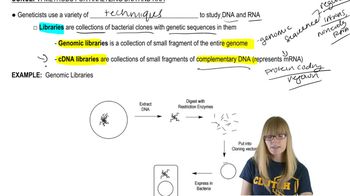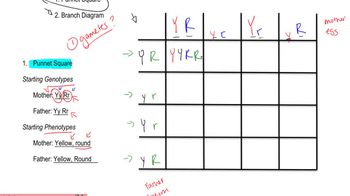A man, J.B., has a sister with autosomal recessive galactosemia (OMIM 230400), and his partner, S.B., has a brother with galactosemia. Galactosemia is a serious condition caused by an enzyme deficiency that prevents the metabolism of the sugar galactose. Neither J.B. nor S.B. has galactosemia, but they are concerned about the risk that a future child of theirs will have the condition. What is the probability their first child will have galactosemia?
Table of contents
- 1. Introduction to Genetics51m
- 2. Mendel's Laws of Inheritance3h 37m
- 3. Extensions to Mendelian Inheritance2h 41m
- 4. Genetic Mapping and Linkage2h 28m
- 5. Genetics of Bacteria and Viruses1h 21m
- 6. Chromosomal Variation1h 48m
- 7. DNA and Chromosome Structure56m
- 8. DNA Replication1h 10m
- 9. Mitosis and Meiosis1h 34m
- 10. Transcription1h 0m
- 11. Translation58m
- 12. Gene Regulation in Prokaryotes1h 19m
- 13. Gene Regulation in Eukaryotes44m
- 14. Genetic Control of Development44m
- 15. Genomes and Genomics1h 50m
- 16. Transposable Elements47m
- 17. Mutation, Repair, and Recombination1h 6m
- 18. Molecular Genetic Tools19m
- 19. Cancer Genetics29m
- 20. Quantitative Genetics1h 26m
- 21. Population Genetics50m
- 22. Evolutionary Genetics29m
2. Mendel's Laws of Inheritance
Probability and Genetics
Problem 6c
Textbook Question
Consider the cross AaBbCC × AABbCc.
Use the forked-line method to predict the expected ratio of offspring phenotypes.
 Verified step by step guidance
Verified step by step guidance1
Step 1: Break down the problem into individual gene pairs. For each gene pair, determine the possible genotypes and their probabilities. For example, for the Aa × AA cross, the possible offspring genotypes are AA and Aa, with probabilities of 1/2 and 1/2 respectively.
Step 2: Repeat the process for the Bb × Bb cross. The possible offspring genotypes are BB, Bb, and bb, with probabilities of 1/4, 1/2, and 1/4 respectively.
Step 3: Analyze the CC × Cc cross. The possible offspring genotypes are CC and Cc, with probabilities of 1/2 and 1/2 respectively.
Step 4: Use the forked-line method to combine the probabilities of each gene pair. Multiply the probabilities of each genotype across the three gene pairs to determine the overall probabilities for each combination of genotypes.
Step 5: Translate the genotypes into phenotypes based on dominance relationships for each gene. Group the offspring into phenotypic categories and sum the probabilities for each phenotype to predict the expected ratio of offspring phenotypes.
 Verified video answer for a similar problem:
Verified video answer for a similar problem:This video solution was recommended by our tutors as helpful for the problem above
Video duration:
3mPlay a video:
Was this helpful?
Key Concepts
Here are the essential concepts you must grasp in order to answer the question correctly.
Forked-Line Method
The forked-line method is a visual tool used in genetics to predict the genotypic and phenotypic ratios of offspring from a genetic cross. It involves breaking down the inheritance of each gene independently and then combining the results to find the overall ratios. This method simplifies complex crosses by allowing for the systematic organization of possible allele combinations.
Recommended video:
Guided course

Methods for Analyzing DNA and RNA
Phenotype
A phenotype refers to the observable characteristics or traits of an organism, which result from the interaction of its genotype with the environment. In genetics, phenotypes can include physical traits like color, shape, and size, as well as behavioral traits. Understanding phenotypes is crucial for predicting the outcomes of genetic crosses, as they represent the traits that will be expressed in the offspring.
Recommended video:
Guided course

Mutations and Phenotypes
Dihybrid Cross
A dihybrid cross involves two traits, each controlled by different genes, and examines the inheritance patterns of these traits simultaneously. In the given cross, AaBbCC × AABbCc, the presence of multiple alleles for two traits allows for a more complex analysis of offspring ratios. The expected phenotypic ratios from a dihybrid cross can often be predicted using the principles of independent assortment and segregation.
Recommended video:
Guided course

Punnet Square
Related Videos
Related Practice
Textbook Question
664
views


